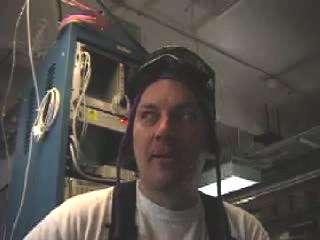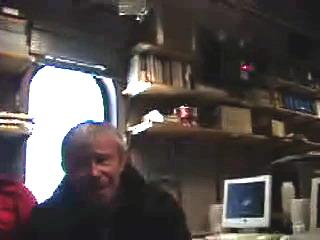
|
|
13 December, 2002
13 December, 2002
A huge day yesterday, I ambitiously planned 5 live streaming webcasts
from different parts of the station, interviewing different
scientists. I've been working on learning to use Apple's QuickTime
streaming server since it was released in August, and have put a huge
amount of time & effort into getting it in place for this moment. I
knew it would be sketchy : it wasn't easy to set up a webcast between
my computer and Gabriella's computer, 2 meters away at home. And
streaming takes a lot of stable bandwidth, and I didn't know how much
bandwidth I could use, and whether the availability of the satellite
internet connections would coincide with my class times back in
Seattle.
But bandwidth here at the pole is mostly excellent, with daily
improvements, thanks to the crackerjack technology support folks. And
were they supportive? Beyond! Great interest and enthusiasm for this
projects.
Here's how it went : the play by play
1st period : 7:45 am in Seattle, so I was up at 3:30 am here (3 hours
earlier and a day ahead), trudging over to MAPO with computer and
camcorder, set up. No scientist for this one, it's just too early.
Jeff in Seattle was able to connect, but no sound! OOPS! I had the
sound box checked off. Reset, and all good. I was able to read emails
and answer students questions without making a phone call. Good!
Break : trudge back over to the Dome for breakfast.
3rd period : 10 am, back in MAPO,joined by Phillipe Herquet. Smooth
and flawless, and recorded for posterity, and posted on my website.
4th period : hurry, hurry: a mile walk with all equipment over to the
Clean Air Lab. Set up, breathless, satellites go down just as I'm
connecting. Back up again in minutes, but can't establish streaming
video. Possibly, 2 satellites working at the same time breaks up the
packets of video information, and send them to Seattle in different
pathways that can't be reassembled properly. A bust.
5th period : Back over to AST/RO, the sub-millimeter radio telescope.
Jeff can see me, but not hear me. Then, when we try to restart the
cast, nothing at all. So I made a phone call to the classroom. Not a
total bust, and fun to talk to students, but not what I had in mind.
There were lots of cool things in the AST/RO lab to show them, and it
seemed pointless to interview astronomer Chris Martin, who was very
patient & tolerant..
6th period : Back to MAPO with Christian Speiring. Video, no audio,
so we made a phone call, kept the video going, and had a pretty
successful ‘cast. This one is also posted on the drachen website.
Final analysis : way more good than bad. Very ambitious (and
exhausting) program, running from place to place and setting up.
Behind multiple satellites, fraught with uncertainties. That it
worked at all : a miracle.
After lunch, Bai & I closed up the ice tank where we've been working,
covering it more thoroughly than ever before, because we didn't
anticipate doing any more work in the tank. It was the first cloudy
day we've had here, and was kind of gloomy.
But another miracle ! The PMTs, which had previously given every
indication of being broken, were delivering signal. Why ? It's not
completely clear, but PMTs give little signal after being exposed to
light. They need to be placed in the dark, usually for several hours,
to "calm down" or "recover." Once they've been in the dark for a
while, they recover their sensitivity to the faint light created by
high energy parcticles traveling through the ice.
We'd given them several hours, and just got bad signals. But after
leaving them covered and in the dark for several days, they were once
again delivering good signals. Not perfect, but 75% of expected.
The suspicion is that the strong UV light here ay the Pole (remember
the Ozone Hole ?) seriously disrupted the light-sensitive
photoelectric material coating the inside of the PMT. Who knew? Well,
Albrecht, Bai's email PMT expert, knew. But it's pretty far outside
the working experience of anyone else here. But all's well that ends
well.
Before dinner, I went up to the 3rd floor of the Skylab building,
where there's a music studio. Last year, guitarist Henry Kaiser came
to the Pole on the NSF's Artists & Writers program. He had a
specially made cold & dry-proof Kevlar guitar made fro the trip. He
has a good start about finding inspiration playing the guitar
outside, using the actual South Pole marker as a slide.
He left the guitar here, and I was able to find it, and played for
most of an hour, mostly loud, through an amp. Definitely a sort of
exorcism, given how tired and foggy I felt.
After dinner, a short meeting of all the AMANDA folks, and I stumbled
off to bed. The long day, the lack of sleep, the altitude, the
overcast weather : I was done.
I slept for 10 hours.

A picture for my boys, Tello, who is 8 and in 3rd grade, and Rico, who's 4 years old. It's very hard being away from them this long...

Your hero, hosting live streaming video webcasts. In order to lend authenticity to my image as a brave polar explorer, I didn't shave (razor frozen, battery dead) or wash my hair (2 two-minute showers per week here at the pole.

Belgian physicist Phillipe Herquet at the South Pole, as seen by my 3rd period students at Roosevelt High School in Seattle. The entire webcast is archived and may be viewed at www.drachen.org

A picture showing a high energy parcticle, probably a muon, a type of heavy electron, moving through the ice-bound AMANDA detector, creating a cone of faint Cerenkov light, which can picked up by the spherical PMTs. This animation is from the AMANDA movie produced by Christian. During the trip, we've been working on English, French, & Russian versions, which are posted at the Drachen site.

German physicist Christian Spiering talked to my 6th period students at Roosevelt High. This entire webcast is also archived at www.drachen.org
Contact the TEA in the field at
.
If you cannot connect through your browser, copy the
TEA's e-mail address in the "To:" line of
your favorite e-mail package.
|
